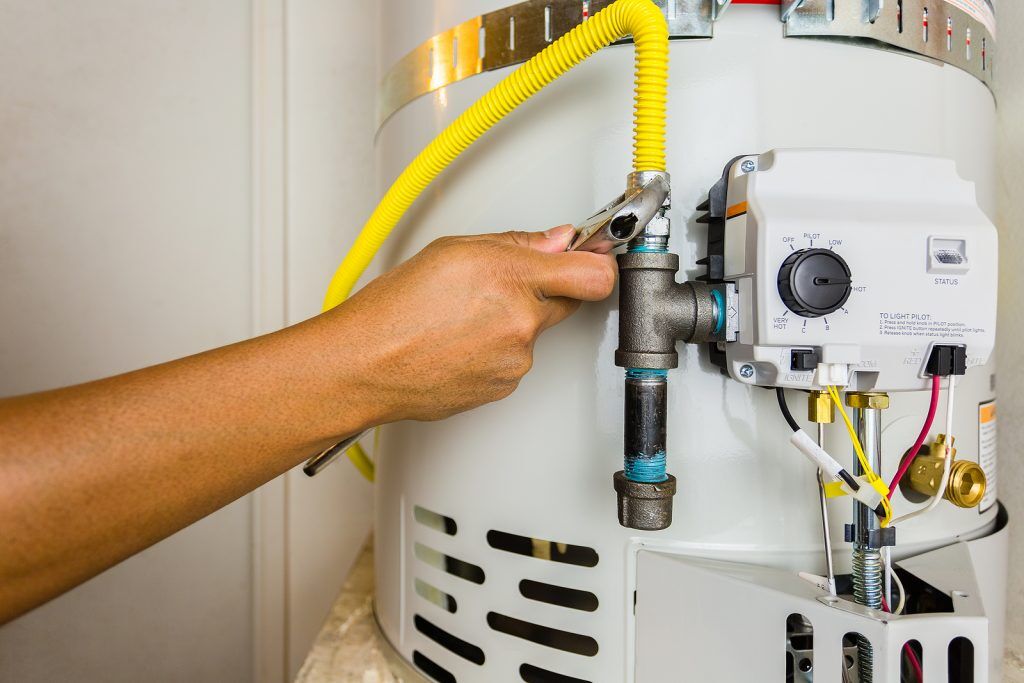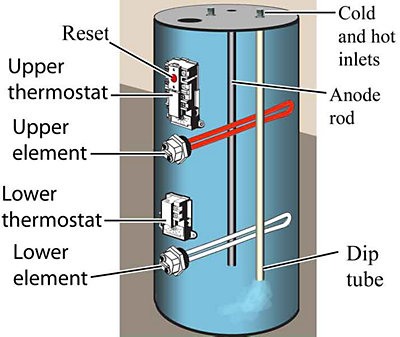Is your water heater giving you trouble, with the reset button constantly tripping? You’re not alone.
This common issue can be frustrating, especially when all you want is a hot shower or to wash a load of laundry. But what if I told you there’s a way to solve this problem and restore your water heater to its optimal performance?
Imagine the peace of mind and comfort that comes with knowing your water heater is back on track. We’ll dive into the reasons why your water heater button keeps tripping and guide you through simple solutions to fix it. Keep reading to ensure hot water flows effortlessly in your home once more.

Credit: www.waldmanplumbing.com
Page Contents
Common Causes
Faulty thermostat often causes water heater button to trip. Overloaded circuits also lead to frequent tripping. Damaged heating elements might trigger button trips, impacting heater performance.
When your water heater button keeps tripping, it can be more than just a minor inconvenience. It disrupts your daily routine and might signal an underlying issue that needs immediate attention. Understanding the common causes can help you troubleshoot and possibly fix the problem before it escalates.Faulty Thermostat
A malfunctioning thermostat often leads to a tripping water heater. The thermostat controls the water temperature, and if it’s faulty, it might cause the heater to overheat. You might notice unusually hot water even when you set a moderate temperature. Replacing a thermostat is a straightforward task if you follow the manufacturer’s instructions. Have you ever tried fixing it yourself, or do you prefer calling a professional? Either way, resolving thermostat issues promptly can prevent further complications.Electrical Issues
Electrical problems can be a significant cause of your water heater button tripping. Loose connections or faulty wiring might disrupt the flow of electricity, leading to frequent trips. Consider checking the circuit breaker and wiring connections. Do you have the right tools to safely inspect these components? If not, it’s wise to consult an electrician to ensure everything is secure and functional.Overload Problems
Overloading is another common cause that might not be immediately obvious. If your water heater is working harder than it should, it might trip the button to prevent overheating. This often happens when the heater is not suitable for the household’s water demand. Think about how often and how much hot water you use daily. Have you recently added new appliances or more family members? Assessing your water usage and possibly upgrading your heater can prevent overload issues and keep your system running smoothly. Addressing these common causes can help you maintain an efficient and safe water heating system. Which of these issues do you think might be affecting your water heater? Taking immediate action can save you from more significant problems down the line.
Credit: www.aosmithatlowes.com
Diagnosing The Issue
A tripping water heater button can be frustrating. It often signals an underlying problem. Understanding the root cause is essential. You can fix some issues with simple checks. Others might need professional help. Start by examining key components.
Inspecting The Thermostat
The thermostat regulates water temperature. If it malfunctions, it can cause tripping. First, turn off the power. Open the access panel. Check for visible damage. A broken thermostat may look burnt or cracked. Use a multimeter to test it. Replace it if needed. A faulty thermostat can lead to overheating.
Checking Electrical Connections
Loose connections can cause the button to trip. Turn off the power supply first. Inspect the wires connected to the heater. Tighten any loose connections. Frayed or burnt wires need replacing. Ensure the power cable is intact. A secure connection prevents electrical faults.
Evaluating Water Heater Capacity
A heater too small for your needs can trip often. Assess the household’s hot water usage. Compare it with the heater’s capacity. Overloading the heater can cause frequent tripping. If the demand is too high, consider upgrading. A larger unit can handle more water and reduce tripping.
Fixing Thermostat Problems
A water heater button tripping can be frustrating. Often, the thermostat is the culprit. The thermostat controls water temperature. If it malfunctions, the button may trip. Fixing thermostat issues can restore your heater’s function. Let’s explore how to address these problems.
Replacing The Thermostat
First, ensure safety. Turn off the power supply. Use a screwdriver to remove the thermostat cover. Check the thermostat for any visible damage. If damaged, replacement is necessary. Purchase a compatible thermostat. Follow the manufacturer’s instructions for installation. Secure the new thermostat in place. Reattach the cover and restore power.
Calibration Tips
Calibration ensures your thermostat works correctly. Set the desired temperature using the dial. Use a thermometer to check water temperature. Adjust the thermostat if needed. Repeat until the water reaches the desired temperature. Regular calibration prevents future issues. Keep your water heater efficient and safe.

Credit: www.mrplumberatlanta.com
Electrical Troubleshooting
Water heaters can often face electrical problems. One common issue is the button tripping. Understanding the electrical components is crucial. It helps in identifying the root cause of the problem. This guide covers essential troubleshooting steps. Let’s dive into wiring inspection and breaker box analysis.
Wiring Inspection
Start by checking the heater’s wiring. Look for any signs of wear or damage. Frayed wires can cause the button to trip. Ensure all connections are tight and secure. Loose wires might lead to electrical faults. Use a multimeter to test the wiring voltage. Make sure readings match the heater’s specifications. Faulty wiring requires immediate repair. Call a professional for complex issues.
Breaker Box Analysis
Next, inspect the breaker box. Ensure the breaker is rated for your heater’s capacity. An overloaded breaker can trip frequently. Check if the breaker feels hot. This might indicate a problem. Reset the breaker and observe the heater. If tripping persists, there might be a deeper issue. Consider replacing old or faulty breakers. Always follow safety precautions during inspection.
Preventing Future Issues
Preventing future issues with your water heater can save time and stress. Regular attention and care ensure it functions efficiently. Addressing small problems early can prevent bigger headaches. Focus on regular maintenance and upgrading components.
Regular Maintenance
Regular maintenance keeps your water heater in top shape. Schedule routine check-ups every six months. Inspect the thermostat and heating elements for wear. Look for signs like rust or leaks. Flush the tank to remove sediment buildup. Sediment can cause inefficiency. Clean or replace filters to ensure smooth operation. Regular maintenance extends the lifespan of your unit.
Upgrading Components
Old components may cause frequent tripping issues. Upgrading can improve efficiency and reliability. Consider replacing old thermostats with newer models. Modern thermostats offer better temperature control. Replace worn-out heating elements for consistent performance. Invest in a high-quality circuit breaker. It can handle the electrical load more effectively. Upgraded components can prevent future malfunctions.
When To Call A Professional
Your water heater button keeps tripping, and you’re left wondering when it’s time to throw in the towel and call a professional. Tackling minor issues yourself can be empowering, but knowing when to seek expert help can save you time and money. You might be thinking, “Can I fix this myself, or is it time to make that call?” Let’s dive into some signs that indicate it’s time to contact an expert, and how to choose the right one.
Signs You Need Help
It’s natural to attempt a quick fix when your water heater acts up. However, persistent issues might signal a deeper problem. Is your water heater frequently tripping the button despite resetting? This could be a sign of an electrical issue or a faulty thermostat.
Have you noticed any strange noises or leaks? These are not minor inconveniences but potential warning signs of a larger problem. Ignoring them could lead to costly repairs or even a complete replacement. Do you feel comfortable handling electrical components? If not, it’s best to leave it to the professionals.
Are you dealing with inconsistent water temperatures? This might indicate a malfunction that requires specialized tools or expertise. Rather than guessing or experimenting, consider consulting an expert for a thorough diagnosis.
Choosing The Right Expert
Once you’ve decided to call a professional, the next step is finding the right one. Start by researching local service providers online. Check reviews and ratings from previous customers. A solid reputation can often be a reliable indicator of quality service.
Ask friends or neighbors for recommendations. Personal experiences can provide valuable insights and help you narrow down your choices. How did your friend’s experience with a particular provider go? Were they satisfied with the service?
Contact a few experts to discuss your issue. Pay attention to how they communicate. Are they responsive and willing to answer your questions? A good professional will take the time to explain the problem and the steps needed to resolve it.
Consider the cost, but remember that the cheapest option isn’t always the best. Compare estimates, but prioritize expertise and reliability. Would you prefer paying a bit more for peace of mind?
Finally, check if they offer guarantees or warranties for their work. This can provide added assurance that your water heater will be handled professionally and effectively.
By knowing when to call a professional and choosing the right expert, you can ensure your water heater is back in top shape without unnecessary hassle or expense. Your comfort and safety are worth it!
Frequently Asked Questions
Why Does My Water Heater Button Keep Tripping?
The water heater button may trip due to electrical faults or overheating. A faulty thermostat or damaged heating element can also cause tripping. Regular maintenance and inspections can help identify issues early. If problems persist, consider consulting a professional to avoid further damage.
How Can I Fix A Tripping Water Heater Button?
Start by checking the thermostat and heating element for damage. Ensure all electrical connections are secure. Reset the button after addressing potential issues. If the problem continues, contact a professional for a thorough inspection and repair.
Is A Tripping Water Heater Button Dangerous?
Yes, a tripping water heater button can indicate serious issues. It may lead to electrical hazards or water damage. Addressing the problem promptly can prevent risks. If unsure about the cause, consult a professional to ensure safety and proper functionality.
Can A Faulty Thermostat Cause Tripping?
Yes, a faulty thermostat can cause the water heater button to trip. It may lead to incorrect temperature regulation, causing overheating. Replacing a malfunctioning thermostat can resolve tripping issues. Regular inspections can help maintain thermostat functionality and prevent future problems.
Conclusion
Fixing a tripping water heater button is important. Regular checks help avoid bigger issues. Start by inspecting electrical connections. Check for any loose wires. Ensure the thermostat works well. Test and replace faulty parts promptly. This prevents future problems. Always prioritize safety when handling electrical components.
Professional help is wise if problems persist. Remember, a well-functioning water heater ensures comfort and efficiency. Keep your system in top shape with routine maintenance. A little care goes a long way. Stay proactive and enjoy a reliable hot water supply.
Simple steps make a big difference.
